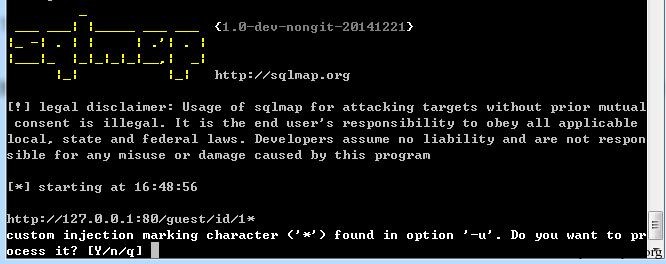
由于还没有找到一款比较适合批量检测sql注入点的工具(proxy+sqlmapapi的方式批量检测之类的批量sql注入点检测),我的目光就转向了sqlmap。虽然sqlmap没有支持伪静态注入点的测试(需要手动添加注入标记),由于是python写的,可以快速方便的进行二次开发。
我的思路是在有.html之类的后缀或者既没有.html或者包含"?"的url进行修改。
伪静态注入点一般都在数字,所以我就在数字后面添加注入标记。字符串的伪静态就不搞了,搞了工作量就会添加很多。
用如下的URL进行测试
#!bash
http://www.site.com/index.php/index/id/14
http://www.site.com/index.php/newsContent/id/341.html
http://www.site.com/show/?29-575.html
结果如下
#!bash
http://www.site.com/index.php/index/id/14*
http://www.site.com/index.php/newsContent/id/341*.html
http://www.site.com/show/?29*-575*.html
代码如下:
#!python
if re.search('html|htm|sthml',url) or url.find("?") == -1:
flag = 0
suffix = ""
if re.search('html|htm|sthml',url):
suffix = "." + re.search('html|htm|sthml',url).group()
urlList = url.split("/")
returnList = []
for i in urlList:
i = re.sub('\.html|\.htm','', i)
if i.isdigit():
returnList.append(i + "*")
flag = 1
else:
returnList.append(i)
url = '/'.join(returnList) + suffix
returnList = []
if flag == 0:
for i in urlList:
if re.search('html|htm|sthml',i):
digitList = re.findall('\d+',i)
for digit in digitList:
i = i.replace(digit, digit + "*")
returnList.append(i)
else:
returnList.append(i)
url = '/'.join(returnList)
print url
相关文件
流程
Sqlmap.py 116行start()->controller.py 256行setupTargetEnv()->target.py 72行_setRequestParams()->target.py 117行
#!python
if kb.processUserMarks is None and CUSTOM_INJECTION_MARK_CHAR in conf.data:
message = "custom injection marking character ('%s') found in option " % CUSTOM_INJECTION_MARK_CHAR
message += "'--data'. Do you want to process it? [Y/n/q] "
test = readInput(message, default="Y")
if test and test[0] in ("q", "Q"):
raise SqlmapUserQuitException
else:
kb.processUserMarks = not test or test[0] not in ("n", "N")
if kb.processUserMarks:
kb.testOnlyCustom = True
这里检测是否使用了注入标记。
sqlmap获取完所有你指定的信息后,开始正式检测是否有注入之前,会检测是否使用了注入标记"*",如果有的话就先处理这个注入标记的点进行测试。
这样就明白注入标记的流程,只要_setRequestParams函数调用之前处理好URL,就可以支持自动的伪静态注入的测试了。
只要在260行处添加
#!python
if re.search('html|htm|sthml',conf.url) or conf.url.find("?") == -1:
flag = 0
suffix = ""
if re.search('html|htm|sthml',conf.url):
suffix = "." + re.search('html|htm|sthml',conf.url).group()
urlList = conf.url.split("/")
returnList = []
for i in urlList:
i = re.sub('\.html|\.htm','', i)
if i.isdigit():
returnList.append(i + "*")
flag = 1
else:
returnList.append(i)
conf.url = '/'.join(returnList) + suffix
returnList = []
if flag == 0:
for i in urlList:
if re.search('html|htm|sthml',i):
digitList = re.findall('\d+',i)
for digit in digitList:
i = i.replace(digit, digit + "*")
returnList.append(i)
else:
returnList.append(i)
conf.url = '/'.join(returnList)
logger.info(conf.url)
这样就可以了。
效果图

这里只是单个的,要支持批量检测注入点。修改这里是不行的。
相关文件
https://github.com/sqlmapproject/sqlmap/blob/master/lib/core/option.py
583行处
#!python
for line in getFileItems(conf.bulkFile):
if re.match(r"[^ ]+\?(.+)", line, re.I) or CUSTOM_INJECTION_MARK_CHAR in line:
found = True
kb.targets.add((line.strip(), conf.method, conf.data, conf.cookie, None))
一行一行读取文件里面的url。只要匹配到有问号"?"或者有注入标记"*"才进行测试。
在583处添加
#!python
if re.search('html|htm|sthml',line) or line.find("?") == -1:
flag = 0
suffix = ""
if re.search('html|htm|sthml',line):
suffix = "." + re.search('html|htm|sthml',line).group()
urlList = line.split("/")
returnList = []
for i in urlList:
i = re.sub('\.html|\.htm','', i)
if i.isdigit():
returnList.append(i + "*")
flag = 1
else:
returnList.append(i)
line = '/'.join(returnList) + suffix
returnList = []
if flag == 0:
for i in urlList:
if re.search('html|htm|sthml',i):
digitList = re.findall('\d+',i)
for digit in digitList:
i = i.replace(digit, digit + "*")
returnList.append(i)
else:
returnList.append(i)
line = '/'.join(returnList)
效果图:

如果有好的建议,可以在评论中给我留言。